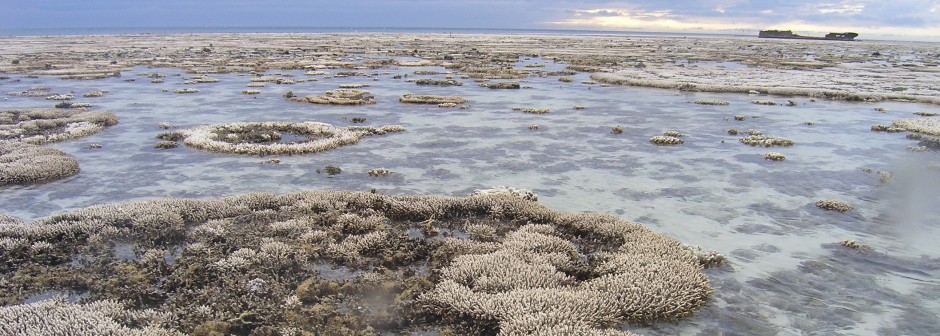For the past two months, I’ve been following coral reefs in the Florida Keys (the only barrier reef on the continental U.S.) as record-breaking sea temperatures persist globally. Corals in the Keys experienced the harshest conditions and bleaching in August – September of 2015 [A]. The result of this bleaching event was reduced coral growth and overall coverage.

Figure 1. Current bleaching threat levels due to surface temperature. This image shows that these reefs are not currently stressed [F].

Figure 2. Projected bleaching threat levels due to surface temperature through July. This image shows that Florida’s reefs will likely not experience bleaching in the coming months [G].
- Ocean acidification, which dissolves coral skeletons
- Overfishing, which removes fish that keep competing algae growth in check
- Predatory starfish
- Invasive species
- Destructive fishing practices, like using cyanide and dynamite
- Pollution from sewage and agriculture
So even corals that survived the bleaching event can’t be classified as safe. They’re still subject to other stressors and are in a weakened state to face them. For corals reefs, it’s not death by fire, it’s death by a thousand cuts.
For the Florida Keys, a region that is very close to large populations of people, those additional factors may prove disastrous. One of the newest potential threats is a proposal to widen shipping channels to access Port Everglades in Fort Lauderdale by dredging. If Congress approves the plan, excavation of the sea floor could begin at the beginning of next year [C].

Figure 3. A large brain coral crushed by a grounded vessel off Port Everglades, Florida. The typical growth rate of this coral is very slow: about .41 cm, or about half of the length of a Cheerio, per year [H]. Photo: Dave Gilliam, National Coral Reef Institute
Despite overwhelming evidence of the disastrous environmental consequences, the promise to “create 7,000 new jobs regionally and support 135,000 jobs statewide over the next 15 years [E]” may win in the end.
It might seem like too much is going against corals, but the fight isn’t over! Despite reef decline, corals remain. This means that there are still things we can do to promote conservation.
For starters, we can focus on removing immediate local stressors like sediment plumes by not dredging the canal to Port Everglades. Simple enough! You can help by writing to Congress about your concerns. Here are a few tips on how to do so!
Another impactful change that you can make is to be careful of the fish you eat. I didn’t touch on it much, but healthy fish communities are essential to coral reef health. Removing some members of that community can be more impactful than others. Here’s a pocket guide for fish to eat/not eat in Texas.
Finally, you can spread awareness about these issues your friends and community. These are global issues that are happening because of small contributions from lots of individuals. The more the people who are fighting to make a change, the stronger the change will be.
Coral reefs are very tangible reminder about how beautiful our planet is, and how fragile that beauty is. It’s an uphill battle, for sure, but it’s one worth fighting for. After all, we’ve only got this one planet and this one lifetime to make a change!

Figure 4. Beautiful, pristine corals near the Millennium Atoll in the central Pacific. Photo: Jennifer Smith
SOURCES:
[B] “Threats to Coral Reefs.” Defenders of Wildlife. Defenders of Wildlife, 2016. Web. 19 April 2016.
[E] “Expansion.” Port Everglades. Broward County Port Everglades Department, 2016. Web. 19 April 2016.

